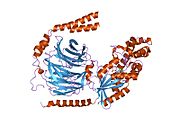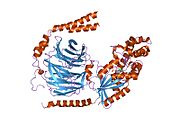GNB1
Izgled
| edit |
Vezujući protein guaninskog nukleotida G(I)/G(S)/G(T) podjedinica beta-1 je protein koji je kod ljudi kodiran GNB1 genom.[1]
Heterotrimerni vezujući protein guaninskog nukleotida (G proteina), koji integrišu signale između receptora i efektorskih proteina, se sastoje od alfa, beta, i gama podjedinice. Te podjedinice su kodirane familijama srodnih gena. Ovaj gen kodira beta podjedinicu, koja je regulator alfa podjedinica, kao i pojedinih receptora i efektora. Ovaj gen koristi alternativne signale poliadenilacije.[1]
GNB1 formira interakcije sa GNG4.[2][3]
- ↑ 1,0 1,1 „Entrez Gene: GNB1 guanine nucleotide binding protein (G protein), beta polypeptide 1”.
- ↑ Ray, K; Kunsch C, Bonner L M, Robishaw J D (September 1995). „Isolation of cDNA clones encoding eight different human G protein gamma subunits, including three novel forms designated the gamma 4, gamma 10, and gamma 11 subunits”. J. Biol. Chem. (UNITED STATES) 270 (37): 21765–71. DOI:10.1074/jbc.270.37.21765. ISSN 0021-9258. PMID 7665596.
- ↑ Yan, K; Kalyanaraman V, Gautam N (March 1996). „Differential ability to form the G protein betagamma complex among members of the beta and gamma subunit families”. J. Biol. Chem. (UNITED STATES) 271 (12): 7141–6. DOI:10.1074/jbc.271.12.7141. ISSN 0021-9258. PMID 8636150.
- Downes GB, Gautam N (2000). „The G protein subunit gene families”. Genomics 62 (3): 544–52. DOI:10.1006/geno.1999.5992. PMID 10644457.
- Levine MA, Modi WS, O'Brien SJ (1991). „Chromosomal localization of the genes encoding two forms of the G protein beta polypeptide, beta 1 and beta 3, in man”. Genomics 8 (2): 380–6. DOI:10.1016/0888-7543(90)90296-7. PMID 1979057.
- Codina J, Stengel D, Woo SL, Birnbaumer L (1986). „Beta-subunits of the human liver Gs/Gi signal-transducing proteins and those of bovine retinal rod cell transducin are identical”. FEBS Lett. 207 (2): 187–92. DOI:10.1016/0014-5793(86)81486-7. PMID 3095147.
- Buhl AM, Osawa S, Johnson GL (1995). „Mitogen-activated protein kinase activation requires two signal inputs from the human anaphylatoxin C5a receptor”. J. Biol. Chem. 270 (34): 19828–32. DOI:10.1074/jbc.270.34.19828. PMID 7649993.
- Ray K, Kunsch C, Bonner LM, Robishaw JD (1995). „Isolation of cDNA clones encoding eight different human G protein gamma subunits, including three novel forms designated the gamma 4, gamma 10, and gamma 11 subunits”. J. Biol. Chem. 270 (37): 21765–71. DOI:10.1074/jbc.270.37.21765. PMID 7665596.
- Kozasa T, Gilman AG (1995). „Purification of recombinant G proteins from Sf9 cells by hexahistidine tagging of associated subunits. Characterization of alpha 12 and inhibition of adenylyl cyclase by alpha z”. J. Biol. Chem. 270 (4): 1734–41. DOI:10.1074/jbc.270.4.1734. PMID 7829508.
- Tsukada S, Simon MI, Witte ON, Katz A (1994). „Binding of beta gamma subunits of heterotrimeric G proteins to the PH domain of Bruton tyrosine kinase”. Proc. Natl. Acad. Sci. U.S.A. 91 (23): 11256–60. DOI:10.1073/pnas.91.23.11256. PMC 45206. PMID 7972043.
- Ueda N, Iñiguez-Lluhi JA, Lee E i dr.. (1994). „G protein beta gamma subunits. Simplified purification and properties of novel isoforms”. J. Biol. Chem. 269 (6): 4388–95. PMID 8308009.
- Wall MA, Coleman DE, Lee E i dr.. (1996). „The structure of the G protein heterotrimer Gi alpha 1 beta 1 gamma 2”. Cell 83 (6): 1047–58. DOI:10.1016/0092-8674(95)90220-1. PMID 8521505.
- Sondek J, Bohm A, Lambright DG i dr.. (1996). „Crystal structure of a G-protein beta gamma dimer at 2.1A resolution”. Nature 379 (6563): 369–74. DOI:10.1038/379369a0. PMID 8552196.
- Andersson B, Wentland MA, Ricafrente JY i dr.. (1996). „A "double adaptor" method for improved shotgun library construction”. Anal. Biochem. 236 (1): 107–13. DOI:10.1006/abio.1996.0138. PMID 8619474.
- Mattingly RR, Macara IG (1996). „Phosphorylation-dependent activation of the Ras-GRF/CDC25Mm exchange factor by muscarinic receptors and G-protein beta gamma subunits”. Nature 382 (6588): 268–72. DOI:10.1038/382268a0. PMID 8717044.
- De Waard M, Liu H, Walker D i dr.. (1997). „Direct binding of G-protein betagamma complex to voltage-dependent calcium channels”. Nature 385 (6615): 446–50. DOI:10.1038/385446a0. PMID 9009193.
- Huang CL, Jan YN, Jan LY (1997). „Binding of the G protein betagamma subunit to multiple regions of G protein-gated inward-rectifying K+ channels”. FEBS Lett. 405 (3): 291–8. DOI:10.1016/S0014-5793(97)00197-X. PMID 9108307.
- Yu W, Andersson B, Worley KC i dr.. (1997). „Large-scale concatenation cDNA sequencing”. Genome Res. 7 (4): 353–8. DOI:10.1101/gr.7.4.353. PMC 139146. PMID 9110174.
- Qin N, Platano D, Olcese R i dr.. (1997). „Direct interaction of gbetagamma with a C-terminal gbetagamma-binding domain of the Ca2+ channel alpha1 subunit is responsible for channel inhibition by G protein-coupled receptors”. Proc. Natl. Acad. Sci. U.S.A. 94 (16): 8866–71. DOI:10.1073/pnas.94.16.8866. PMC 23172. PMID 9238069.
- Nishida K, Kaziro Y, Satoh T (1999). „Association of the proto-oncogene product dbl with G protein betagamma subunits”. FEBS Lett. 459 (2): 186–90. DOI:10.1016/S0014-5793(99)01244-2. PMID 10518015.
- Huang L, Shanker YG, Dubauskaite J i dr.. (2000). „Ggamma13 colocalizes with gustducin in taste receptor cells and mediates IP3 responses to bitter denatonium”. Nat. Neurosci. 2 (12): 1055–62. DOI:10.1038/15981. PMID 10570481.
- Carman CV, Barak LS, Chen C i dr.. (2000). „Mutational analysis of Gbetagamma and phospholipid interaction with G protein-coupled receptor kinase 2”. J. Biol. Chem. 275 (14): 10443–52. DOI:10.1074/jbc.275.14.10443. PMID 10744734.















